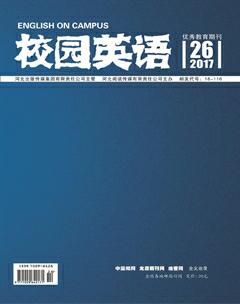Appreciation of Ships in the Desert
Shi+Jinxin+GuoHongyan
Ships in the Desert is an excerpt taken from Earth in the Balance, a book written by former US Vice President Al Gore who focuses on constant researching on the underlying causes of the environmental crisis for years. The author illustrates how serious the global environmental crisis was and the problems that human being was facing, which need human beings to adopt urgent and effective measures to solve. He is accurate in word selection and clear in structural arrangement.
At the lexical level, firstly, the author employs a number of nominal words, especially abstract nouns, to express action or situation. Nominalization makes the language static and makes the content brief and accurate, like the concentration of carbon dioxide, heat-absorbing molecules.
Second feature is the use of preposition, such as “As a result, any solution to the problem will require a careful assessment of that relationship as well as the complex interrelationship among factors within civilization and between them and the major natural components of the earths ecological system.” There are six prepositions in a single sentence, thus the context plays a vital role in comprehension.
The third feature is the deployment of formal words, more literary words which originated from Latin and Greece instead of more colloquial ones, such as the use of “permanently” and “fundamentally” rather than “long-lasting” and “basic”.
The forth feature is the deployment of less technical terms. The words chosen are common and concise, like core sample, glacier, polar ice cap, natural gas, landfills, acid rain. The only technical terms perhaps are “noctilucent cloud” and “methane gas”, but the author gives explanations in detail for both.
At the syntax level, the author prefers long sentence. A large part of text consists of long sentences with more than 30 words, and the longest one reached 82 words, which constitutes a whole paragraph. Within two key causes are manifested by the combination of several grammatical levels, such as nominal clause, preposition phrase, coordination and attributive clause.
At the grammatical aspect, firstly, passive voice is used more frequently. Because this text belongs to exposition of science, the center of a sentence focuses on the description of some phenomena, or the object and mode of an action.
Secondly, the author employs different kind of attributive expression, like post positive attributive and attributive clause. For instance, “capable” in “I was standing in the sun on the hot steel deck of a fishing ship capable of processing a fifty-ton catch on a good day.” As to the attributive clause, there are too much scattered in the text.endprint
At the textual level, by talking about ships in the desert which used to be the inland sea, and where there should have been gentle blue-green waves lapping against the side of the ship but which now is a desert, the author naturally introduces a subject of the environmental crisis. The organization pattern of this text is to make presentation first, then do analysis and finally put forward solutions to the problems. The whole text can be divided into three parts:first part describes the images of the reality we are facing now, second part includes a transition and the cause analysis of the phenomena within part one and the last part is mainly for appealing.
The second part begins with a summary and a serial of questions, which stands as a connecting link between the preceding and the following paragraphs. Furthermore, the author explains the classified criteria of global threats and then states them as well as their causes one by one. Within these paragraphs, there is also a word stood as a connecting link between the preceding and following sentences like strategic, relationship, change, changes and explosion.
At rhetoric aspect, the author uses parallelism to achieve emphasis and grasps readers focus. For instance, three sentences have the common beginning “noctilucent cloud” in paragraph 7, so do the three questions begin with “why” in paragraph 9, showing a strong power. Besides, there exists a metonymy to avoid the simple repetition. In the end of paragraph 6, here “thousands of songs” represent “species of birds”.
In conclusion, this text is a model of exposition. No matter on its lucid, passionate and powerful language, or on its well-structured construction, this text can inspire readers not only in writing but also in thinking.endprint

